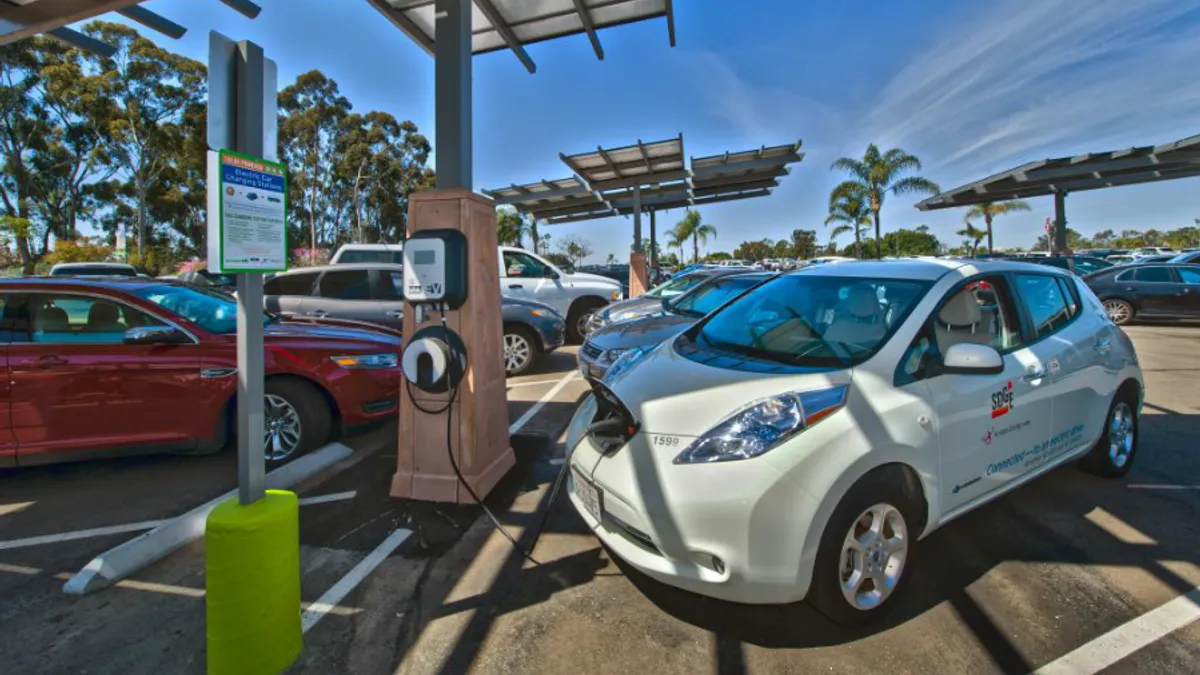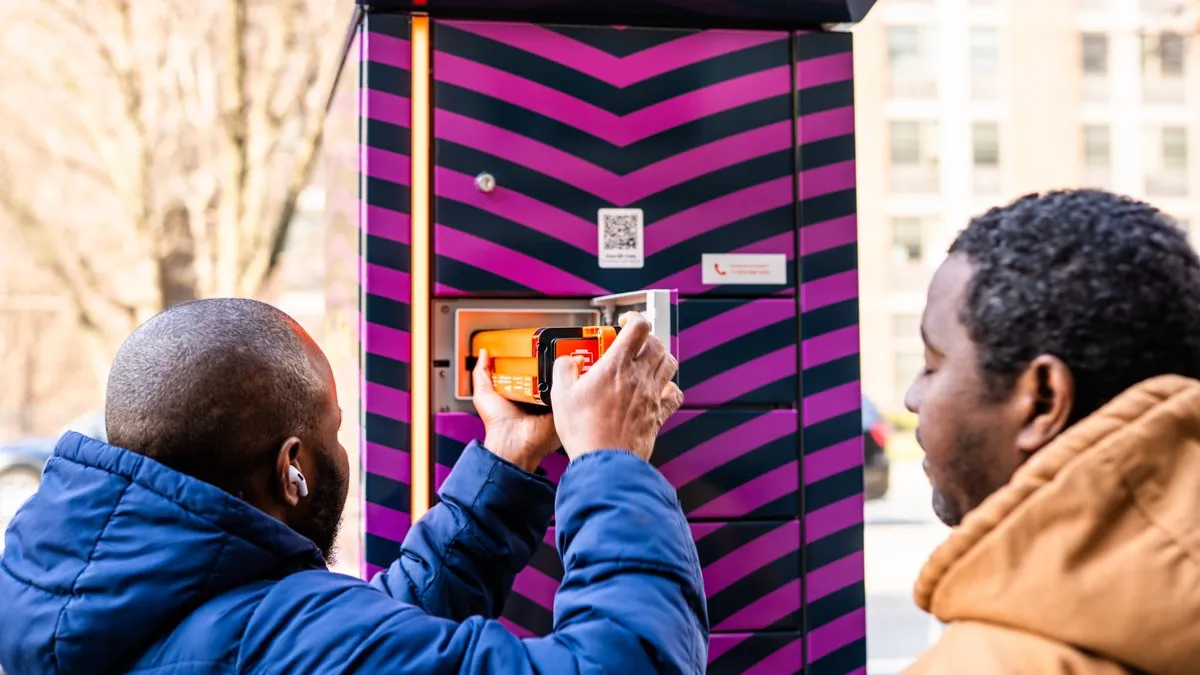That utilities have a lot to gain from the electric vehicle transition is common knowledge. But if they don’t act, they could also have a lot to lose.
The potential problems are clear in a recent estimate from the Sacramento Municipal Utility District (SMUD). Highlighted in a new EV charging report, the utility forecasted that EV-related overloads could necessitate replacing 17%, or 12,000, of its transformers at an average cost of $7,400 each.
That’s only one municipal utility, and the impacts on the entire U.S. grid scale accordingly. The 580,000 EVs on the road in the U.S. today represent 1 TWh of consumption, but by 2040, that could grow to 551 TWh, according to a recent report from the Smart Electric Power Alliance.
Whether those EVs turn into a blessing or a curse for utility companies depends on what they do today, said Erika H. Myers, the SEPA research director and author of the report “Utilities and Electric Vehicles; The Case For Managed Charging.”
“Utilities are waiting until EV penetrations rise but they should be at the table now to impact decisions now being made,” she said.
The paper urges utilities to be proactive in decisions that can “modulate charging so that it coincides with grid needs instead of becoming a stressor on the grid,” Myers said.
Decisions are being made about how EV charging will be controlled that range from standards for the charging equipment deployed to regulations that govern charging rates.
“The transportation sector has never had to think about utility rates,” Myers observed. As the two sectors' needs come together, collaboration will be “absolutely essential.”
Working together, utilities and car companies can effectively manage the new load patterns about to come at utility distribution systems, the paper argues. Managed charging can result in benefits to utility customers, the grid, and private charging providers, while also allowing the integration of more renewables. But utilities have to start now to get it right.
“To be an asset of grid-scale value, EVs would need to be at least 5% to 10% of new car sales, but they are around 1%,” said Edison Electric Institute (EEI) Sustainable Technology Manager Kellen Schefter. “What is important now for electric utilities is to find out what works best for the market and for customers. They can help move electric transportation to the scale where they can take advantage of the opportunities.”
The EV charging opportunity
Many opportunities are linked to managed charging, Myers said. EVs can be a huge flexible load if utilities learn to effectively manage charging. If left unmanaged, they could make utilities’ grid management more difficult.
But traditional utility strategies come with new challenges, Myers said. Time-of-use (TOU) rates that shift peak demand, for instance, can have unintended consequences.
“Drivers often schedule charging to start at the moment rates drop,” the paper reports. The result can be a “timer peak” in which load ramps too sharply for the utility to effectively respond.
Managed charging is also called V1G, which clarifies its role as a precursor to vehicle-to-grid (V2G) dispatch. V2G is still a theoretical concept, according to the paper, that faces technical, regulatory, and practical hurdles.
Emerging V1G capabilities can allow a utility to turn its charging load up, down, or off to balance grid conditions. With adequate visibility and control, system operators can use EV load “like demand response,” Myers said.
Managed charging can also allow utilities to benefit from overgeneration from renewable power sources, Myers added. Effective price signals and successful customer education can shift charging loads to when there are high levels of midday solar and overnight wind that might otherwise be curtailed.
A recent SEPA survey found 69% of utility professionals are “planning, researching, or considering” demand response (DR) programs that include managed charging, the paper reports.
The paper has four major themes, Myers said. The first is a review of how utilities can do managed charging. The second is a review of stakeholders now aggregating the EV charging load and the communication systems they are using. The third is a review of the hardware those stakeholders are using.
“The fourth and most over-riding theme is that customer engagement is critical,” Myers stressed. “There are no vehicles to integrate unless the utility gets the customer to buy into the vision.” That is why the paper reports utility strategies must include “user-friendly features, flexibility, and incentives.”
Better TOU rates could be the most widely-accepted customer engagement strategy. If they are flexible enough to accommodate customers’ needs, they can lead to “advantageous charging habits,” Myers said.
Another crucial but missing factor for managed charging is the least-cost, best-fit solution for interoperability between utilities, EVs, charging stations, and drivers.
Focus on communications
“Interoperability continues to be a big challenge for DR, and EV charging faces the same challenge,” Myers said. “The first thing that is needed is a common communications standard.”
A well-designed network communications standard would deliver “inexpensive” and “reliable” interoperability, according to the paper.
An estimated one-third of electric vehicle equipment manufacturers have a managed charger offering, it reports. About half of EV manufacturers are involved in or associated with managed charging pilots or have managed charging capabilities.
A common communications standard is “the most effective way to move the needle on managed charging,” the paper reports. It would consist of messaging/application protocols, like Open Automated Demand Response (OpenADR) 2.0 and OCPP, and transport protocols that serve as Wi-Fi, cellular, or other network interfaces.
The first step is identifying “a uniform messaging protocol” from the many open and proprietary protocols now being deployed, the paper reports. “The messaging protocol contains the instructions — don’t charge until after midnight, for example — while the network protocol ensures a message gets from point A to point B.”
Utilities can work with manufacturers to develop standards and best practices and “run pilots to test them,” Myers said. Like the cellphone industry, utilities and EV industry stakeholders will eventually find their way to interoperability, Myers said. “It will ultimately come down to functionality and price.”
Interoperability challenges
With the necessary communications capabilities in place, utilities will be able to network charging infrastructure for grid services and implement rate designs that meet customer, market, and grid needs, Myers said. But EEI’s Schefter cautioned that it is too early to be “overly prescriptive” about communications protocols and standards.
“There is too much happening on the grid with distributed solar and behind-the-meter battery storage, which also are managed through communications signals,” he said. “We don’t want an EV-specific standard that conflicts with other standards.”
EVgo is the biggest U.S. provider of direct current fast chargers (DCFCs). Vice President Terry O’Day agrees it is important to prepare for managed charging but believes today’s OpenADR is a sufficient platform.
It is used for demand response now and utilities should consider offering incentives to charger makers to provide software-compatible equipment, he said.
Bill Boyce is Sacramento Utility District (SMUD) Manager of Electric Transportation Research and Development. SMUD currently has about 5,400 EVs in its territory and an estimated 30% are on TOU rates.
A single communications standard is not the least-cost option and utilities will be reluctant to pay for it, Boyce said.
SMUD estimates that such a “communications layer’ could cost $200 per car per year, which would be "as much as changing out all the transformers,” he said. “Our one message is that these communication systems have to be really low cost — probably $20 per year to $30 per year — to be cost effective.”
Moving to a single communication standard is also “limiting” to an early-stage market, he added. “To make a real business case, we should have as much flexibility as possible and keep the cost as low as possible.”
ChargePoint is the biggest U.S. charging station provider. “The total load of a developed market has to be managed to flatten the curve for utilities and share the benefit with other ratepayers,” Vice President for Utility Solutions Dave Packard said.
The company is now working with Southern California Edison (SCE) on a pilot that will test the OpenADR protocol.
“With 500,000 electric vehicles, we’re not at a critical mass. At 50 million, we’ll be at a critical mass and we’re going to see impacts on utility systems,” Packard said. Pilots now being deployed in California by SCE, San Diego Gas and Electric (SDG&E), and Pacific Gas and Electric “will instruct utilities across the country.”
The other part of the equation is getting rate design right, Packard said. “We can start with time-of-use rates.”
Focus on rates
Rate design that guides and manages EV charging is supported by most stakeholders. Charging services provider eMotorWerks estimates customers could be compensated up to $400 per year for responding to a utility DR program’s price signals, the paper reports.
That will be valuable to the utility because it could incline customers to further participation, which would be a “virtuous cycle” that leads to a bigger EV load and better grid services, Myers said.
The rate design must give customers flexibility to participate when they can and opt out when they need to, Myers said. It will only be workable if the utility can communicate system needs to the car, charger, and driver and the driver can communicate availability.
The SDG&E Power Your Drive TOU rate will be tested at 3,500 charging stations now being deployed at 350 SDG&E locations. All program vendors are required to have the necessary communication capabilities, Myers said.
The Power Your Drive TOU rate has been tested for two years with 362 utility employees who drive plug-in cars, said EV customer engagement manager April Bolduc.
“My understanding is that we’re the first utility in the country to offer this rate,” she said, “but we’ve seen from our testing that drivers listen to price signals.”
SDG&E has developed what the paper describes as “customer-centric” features. They include opt-out and override controls, messaging and alerts delivered to customers via their smartphones based on their expressed preferences, and “rewards, rebates, and other perks” to keep customers engaged.
Each participating charger vendor will provide an app that meets SDG&E parameters, Bolduc said. “When they receive day-ahead hourly California system operator rate information via SDG&E, they transmit it to the customer.”
Packard said ChargePoint partnered with SDG&E on the Power Your Drive program design but the utility required the rate to be available through any vendor.
“It’s stretching the limits because it will give drivers the benefit of deciding when to charge their car and how much they want to pay,” he said.
The program is designed to engage drivers because there is a concern, despite employees test program responses, that drivers will see dealing with TOU rate price signals as too much work, Packard said. “The rates are structured so it’s a huge benefit if you charge off-peak but it is not a big penalty if you charge on-peak.”
EEI’s Schefter said the Power Your Drive rate’s flexibility is important because “as utilities’ loads and generation portfolios evolve, it can still be the right answer.”
SMUD’s Boyce insisted it is premature to be overly concerned with anything but the right price signals. He endorsed the SDG&E TOU rate and said SMUD is developing something similar but “more dynamic.” He is certain that if price information is available, the market will support customers’ demand for cost savings and control of their charging.
EVgo’s O’Day also endorsed the SDG&E rate. The role of the utility is to send a price signal or another kind of a signal to enable drivers, he said.
‘Just cars’
Utilities will play a critical role in moving the U.S. away from gasoline-powered vehicles, Myers said, as their “deep knowledge” of the grid will be “key to finding the most cost-effective strategies to optimize managed charging solutions for the benefit of the entire grid.”
EEI’s Schefter agreed, calling transportation electrification “an unprecedented opportunity to leverage electric utility grid management and financial resources.”
But SDG&E’s Bolduc said it best. “In a few years, EVs will be ‘just cars’ and managed charging is a way we can integrate them into a century-old grid.”



















